The 38 Special revolver has long been a standard as a back-up and concealed-carry handgun. As part of our new Bargain Hunter series, we wanted to challenge the conventional notion that a wheelgun chambered in 38 Special should be the de facto winner of any boot-gun showdown simply because it has always won those battles in the past. In the same power range as the 38 Special is the 9mm Luger (aka 9mm Parabellum or 9x19mm), which has the added benefit of being loaded more widely, often at less cost per round, than the 38 Special. Also, many carbines are chambered for 9mm, which makes it a handy choice for a long gun/handgun duo, even if the handgun is a revolver. To be fair, the 38 Special is also chambered for long guns, primarily lever guns. On the 38 Special’s side is the fact that dozens of revolvers from Smith & Wesson, Ruger, Rossi, Charter, Taurus, and many others are chambered for the round, compared to a paltry few 9mms, some of which must use half-moon or moon clips to function. In this two-way test, we evaluated four handguns, three revolvers chambered for 38 Special and two revolvers chambered for 9mm Luger. Certainly, the best gun would win and earn our favor. But we also looked at the cost of consumables to see if, over time, one cartridge had an edge.

When we began researching this test, it seemed that economics put the 9mm squarely ahead of the 38. On a price-per-round basis, we found more 9mm ammo at a lower price than similar bullet weights of 38 Special. For example, one of the better deals we bought before the current troubles started were Brownells 500-round ammo bundles (both included MTM ammo boxes): Winchester USA White Box 9mm Luger 115-gr. FMJ Q4172 500-Round Ammo Can Bundle, $125/500 (Brownells #105-000-025WB); and Winchester USA White Box .38 Sp. Q4171 500-Round Ammo Can Bundle, $200/500 (Brownells #105-000-023WB). The price per round for the 9mm bundle was 25 cents, a whopping 38% less than the 40-cents-per-round cost in the 38 Special bundle.
But as we began shooting, the ammo market went nuts, and now, practically every retailer is periodically out of most brands, calibers, and bullet weights, and our old pricing comparisons are out the window. We can’t forecast when prices might return to pre-December 2012 levels, if they ever will.
Wal-Mart is the nation’s largest retail ammunition supplier, but because the firm doesn’t list prices online and because the transactions must be face to face in local markets where prices may vary, we instead looked to Cheaper Than Dirt! for comparative information of actual ammo for sale at the end of January. At Cheaper Than Dirt!, which industry sources tell us is the second-largest ammunition retailer in the country behind Wal-Mart, both 38 Special and 9mm appear in the “Most Popular” header of the company’s website, CheaperThanDirt.com. CTD (as of late January) offered 283 loads of 38 Special, with seven being in stock. Meanwhile, CTD offered 334 9mm loads, with just 12 being in stock. Both cartridges have a variety of bullet styles available from a variety of manufacturers, so there’s no significant advantage either way.

Of the in-stock ammunition, we compared the bullet-weight ranges and prices for everything CTD sold in 9mm Luger and 38 Special and still found a difference. The 38 Special rounds available today at CTD cost $1.17 each on average, with a low of 87 cents per shot for the Winchester Super-X Lead Semi Wadcutter X38WCPSV (see table). The available 9mm ammunition cost $0.89 each on average, for a 28-cents-per-shot difference (24%). The TulAmmo 115-grain FMJs were the low-price winner, coming in at 38 cents a round. In fact, six of the 9mm choices were cheaper than the Winchester rounds, the lowest-priced 38 Special. And the 9mm doesn’t come at any power penalty — in fact, it offers a power advantage. Our test samples of 9mm produced 378 ft.-lbs. of energy on average compared to the 38s’ energy figure of 305 ft.-lbs.
So going into actual testing, our two 9mm revolvers, the Charter Arms 9mm Pitbull #79920, $465; and a discontinued Smith & Wesson 940-1, which often sells for a premium between $595 to $671, had advantages in operating costs and power. We pitted them against a Smith & Wesson Model 638 38 Special, $459, which we fired alongside a mint blued Model 38 Airweight, and a Charter Arms Police Undercover No. 73840 38 Special, $402.
Unlike the 940-1 Smith, the Charter Pitbull 9mm is notable for not needing moon clips to operate. The Charter Arms 9mm Pitbull revolver makes this possible by using a dual coil spring assembly in the extractor that holds a standard rimless 9mm round in place, then ejects it like any other standard revolver. This placed the Pitbull on the same level as the Charter Police Undercover and the Smith & Wesson Model 38, giving it a distinct advantage over the 9mm 940 that needed moon clips to successfully eject the rimless 9mm rounds. We tested all four revolvers with Winchester, Fiocchi and Hornady rounds in their respective calibers. We tested for accuracy firing each revolver double action from 7 yards, the Smith and Wesson 940 is a double action only hammerless revolver. Overall, each pistol had its merits, but our testers found out why the snubby 38 Special has been a concealment standard for decades.
Smith & Wesson Model 638/38 38 Special, $459
We had the opportunity to fire the 638 alongside an older Model 38 Airweight, the blued progenitor of the stainless current model. Both 38-series revolvers performed well and showed us what the 940 was missing. We tested for accuracy firing double action because the 940 does not have a single-action option. Accuracy improved when we fired the 38 series handguns using their single-action triggers rather than the heavy double actions.

The hammer tops on the M638/38s were grooved steel and were shrouded by the frame except for the top 1⁄8 of an inch, giving the shooter the option of firing single action while taking away the risk of catching the hammer on something while holstering or moving around. Our accuracy was hurt by the smaller wooden grips on the M38. We found that it was difficult to maintain a strong grip throughout the M38’s trigger pull and more so through multiple shots. We fired plenty of rounds single action and as expected our accuracy improved and the narrow grips were not a problem. The advantage of the small grip is that this revolver is easily concealed, and its lightweight frame won’t tire you out. The rubber grip on the 638-series J-frame revolver leaves the backstrap bare and ends even with the bottom of the grip frame or butt, just like the 940.
Both the M638/38 lacked a shroud underneath the barrel, leaving the ejector rod unprotected. This model did not include a crane detent and used the ejector rod for additional lockup. The ejector rod itself was noticeably shorter as well. Both guns’ rear sights consisted of a simple topstrap notch without an adjustable blade. Its front sight was a lined ramp machined into the barrel shroud.
At the range we approached the long, heavy double-action trigger press on each of these guns by pulling straight through and staging the triggers. Overall, staging — pulling up about 3/4 of the DA pull length then pausing before breaking the shot — produced better accuracy and control of the guns. But no matter how we shot the 638-3, the key to controlling the elevation of our hits was mastering the grip. On the 638, the side panels were rounded to fill the palm, and there was a scoop for the trigger-hand thumb to press into. Unquestionably, for shooting, the rubber grips on the M638 were better than the M38’s wood grips. More than anything, however, we believe the sights are the biggest detriment to accuracy. We’d strongly consider adding Crimson Trace lasergrips to either gun if we wanted more accuracy.

At the 7-yard bench, we found the Smith & Wessons to be suitably accurate for boot guns. Firing the 130-grain Winchester USA FMJs produced 1.9-inch five-shot groups in both guns. With Winchester 115-grain FMJs in both 9mms, that was more than a half-inch worse than the Pitbull’s 1.3-inch average, but a half-inch better than the 940’s average group size. And both 9mms produced substantially more power than the 38s. Also, with Fiocchi 130-grain FMJs, the M638 was much less accurate than the Pitbull and 940 when firing Fiocchi 115-grain FMJs. With Hornady Critical Defense 110-grain FTXs, the M638 bested the 940 in accuracy but still trailed the Pitbull by a half-inch in average group size. The Charter Police Undercover was by far the accuracy dog with all three ammos, which we’ll cover in a moment.
Our Team Said: We liked both iterations of the S&W 38 revolver for their no-frills functionality. The more modern M638 had better grips, but we also liked the understated blued M38. In the latter case, we would strongly consider bidding on a M38 online and upgrading it with new grips and lightening the DA trigger pull.
Smith & Wesson Model 940 9mm Luger, $595 to $671
This five-shot 9mm revolver requires moon clips to eject the standard rimless rounds. Although this is what we are used to when using a 9mm revolver, we still think it’s a pain. The hammerless double-action system was safe for obvious reasons, but we preferred the covered hammer and single-action capability of the 638/38.
Still, our biggest complaint about the 940 wasn’t the need for moon clips or the DAO firing mechanism. It was the weight of the polished stainless-steel frame, which was 10 ounces heavier than the Smith 38s. Also, the frame and cylinder are polished stainless steel, and many of its surfaces were highly reflective. The top of the frame and the sights are a matte finish so as to not reflect light. Where the frame curves up to the sights where a hammer would normally reside, the frame is polished steel and reflects lights above and behind the shooter. During testing, to be able to see the rear groove sight, we had to turn the lights off behind the benches in Tactical Firearms’ indoor range.
Our Team Said: The Smith & Wesson 940 is no longer in production, and we think this speaks volumes as to how the shooting public feels about a 9mm revolver when the option of a solid 38 Special revolver is available. Also, in some cases, online prices for used 940s are higher than the original’s MSRP. On the one hand, that means the 940 has followers who are willing to pay a premium for these guns; on the other hand, joining that following is too expensive for us to recommend because there are better 9mm and 38 Special choices available.
Charter Arms Pitbull No. 79920 9mm, $465
Charter has raised the bar for 9mm revolvers with this addition to the product line. The Pitbull is not perfect, but it is vastly superior to other 9mm revolvers we’ve tested. The spring-driven ejection system is essentially a built-in moon clip that clamps into the casing groove. This allows a shooter to use the more readily available and cheaper rimless 9mm ammo, if the ejection system works as it’s promoted.
But hold on. The ejection system is great if the pin is pushed quickly and the revolver is pointed up at an angle. We did have some spent brass that was less than cooperative, but, overall, the system worked well. We did notice that the front edge of the casing would occasionally catch on the ejector system when loading rounds, but either removing the round and reinserting it, or pushing harder at an angle would clear things up. Our final criticism of the system is that it takes away an advantage moon clips provided — speedy reloads. Without a speedloader, the ability to simply drop all the rounds in at once is lost with this system since we had to push each round individually past the ejection system. Another option is to load from a Tuff Quickstrip, but we didn’t try that in this test.
This criticism seems harsh considering how highly we rated the Pitbull, but this is essentially where the criticism stops. Charter produced the most accurate gun in the test by having clearer larger sights and a much larger grip. The Pitbull was easy to control and we enjoyed testing it, and we believe that as a range gun or training gun, it would be fantastic, though we feel it would be too large to carry as a back-up like the 38 Specials tested above.
Our Team Said: Our only complaint about the Pitbull is that the ejection system isn’t perfect, though as stated above, we also feel that it is a better option than having to load moon clips and having to worry about when the moon clip is going to break. Taking into account its lower operational costs, the Pitbull is worth considering ahead of the S&W 638. In particular, for the shooter who already invests in 9mm ammo, we’d pick the Pitbull rather than adding another caliber we had to support.
Charter Arms Police Undercover No. 73840 38 Special, $402
The Charter Police Undercover almost matches the Pitbull, except for the chambering and the ejection system. And for much of the test, the Undercover seemed like it was headed for a strong showing.
Like the Pitbull, the Undercover’s large rubber grip and easy-to-reach hammer, along with the smooth trigger pull, made the Undercover a smooth-firing carry choice. The problem was accuracy.
We fired our first six shots at center mass on a standard silhouette target from 7 yards, just like the other revolvers in the test. Unlike the others, the Undercover consistently dropped shots 6 to 8 inches low. All of our shooters were having the same problem, so we took the pistol to Jack Everett of Jack’s Gun Shack in Tactical Firearms in Katy, Texas. Giving the revolver a thorough inspection, Everett discovered very shallow rifling grooves that were packed with brass, essentially creating a smooth bore revolver. We cleaned the barrel and cylinder very thoroughly multiple times, but we couldn’t solve the performance problem or improve condition of the grooves. The big groups — two to three times the group sizes of the other guns, and the low point of impact — eliminated it from consideration.
Our Team Said: As is, we wouldn’t buy the Charter Arms Police Undercover. However, we will return the gun to the factory because, in our opinion, the condition of the barrel is a manufacturing flaw that must be covered under warranty. If the “smoothbore” barrel was just a mistake that got through QC and Charter Arms rectifies the problem, then we’ll reshoot the Police Undercover and revise the final grade online and report the results in a future issue.
Written by Austin Miller, using evaluations from Gun Tests team testers. Photography by GT staff. GT































Have you ever tested the Smith &Wesson 638 Airweight?
Please tell me which issue since I’ve saved mine but loaned them to someone.
Thank you for your help and great publication.
Ted Peck